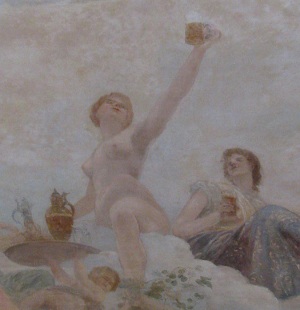
In which the author visits Le Bourbonnais, a little-known area of central France in the department of Allier within the region of Auvergne, encounters local cheeses, Charolais beef and Saint Pourcain wines, and gets smart by sticking his head in a saint’s tomb.
Where is Allier?: The department of Allier is in the center of France within the region of Auvergne. Specifically, my destination was an area within Allier known as Pays Bourbon or Le Bourbonnais. Le Bourbonnais was the feudal fiefdom of the Bourbon family whose descendants eventually became kings of France and Spain. Spanish King Juan Carlos I is a Bourbon as is Grand Duke of Luxembourg Henri I. The capital of Allier is Moulins, 2:23 by direct train from Paris. The Allier River runs through Moulins.
Amount of time: 2 days, 1 night, but would have liked an additional day to visit more wine producers and Charolais farmers.
Local products tasted, tested, enjoyed: Saint Pourcain wines, Charolais beef, several cheeses.
Notable sights in Le Bourbonnais
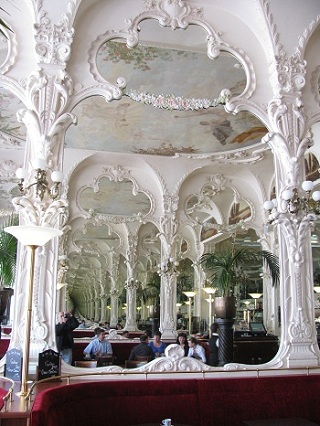
In Moulins: National Center for Theatrical Costumes and Scenography (Centre National du Costume de Scène), offers some fabulous temporary exhibits for admirers of costumes, fashion and stage performance of all kinds; Mantin Mansion (Maison Mantin), restored home a wealthy man of the late 19th-century left more or less as it was, according to his will, plus the adjacent and Anne de Beaujeu Pavilion/Museum; Le Grand Café, an Art Nouveau café-brasserie whose 1899 décor is listed as a historical monument; a walk in the old town.
Romanesque-at-heart churches near Moulins: The Priory Church of Souvigny (Eglise prieurale St-Pierre et St-Paul), contains the tombs of the Dukes of Bourbon and is the subject of a fascinating guided tour; Saint Menoux Church, Eglise Saint-Menoux, in the village of Saint Menoux, where legend has it that sticking one’s head in the saint’s tomb (it has a big hole in the side and yes you can) is said to render the simple-minded more intelligent.
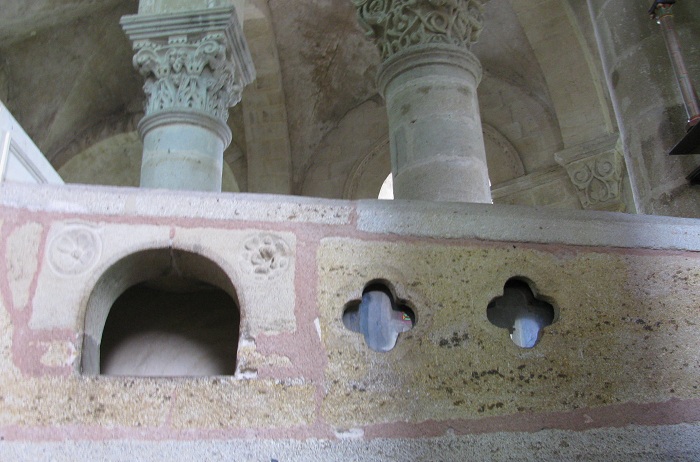
Bourbon-l’Archambault: An old spa town with ruins of the feudal fortified castle of the Dukes of Bourbon. Rooms in two castle’s towers contain exhibits that about castle life in the Middle Ages; especially designed for children but informative for all. See restaurant noted below.
TASTED, TESTED
CHEESE
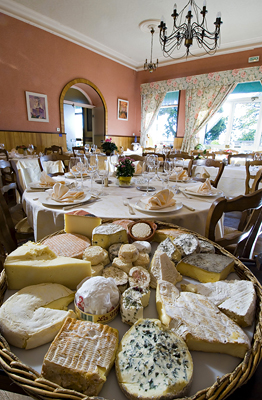
Gaperon, a cow cheese with garlic and a bit of pepper. Dome-shaped, with a natural white crust, medium soft (elasticky) inside, made from raw or pasteurized milk. Not strong to the smell but with a nice little (not overwhelming) peppered garlic kick to it. Traditionally cured by hanging from a string on a hook by a fireplace. The name gaperon comes from gape, meaning buttermilk in a local dialect, since buttermilk was originally added. Its origin is actually said to be in the area of Billom, Auvergne’s garlic capital, in the department of Puy-du-Dome which is just south of Allier. For that reason it’s pared with Cotes d’Auvergne red wines, which, like the reds of Saint Pourcain tested here, are made from gamay and pinot noir grapes.
Sept-Fons, a cow cheese made by Trappist monks in the Abbey of Notre Dame de Sept-Fons in Dompierre-sur-Bresbe.
Cérilly, a very fresh cow cheese preferably made with raw milk by the cheese producing company Déret et fils. There are different versions of Cérilly, from a fromage blanc version to slightly aged versions with a crust by way of the fresh, white, mild spreadable version that I enjoyed. (Déret et fils also produces a blue cheese called Bleu Bourbon.)
Sept-Fons and Cérilly stood out among the cheeses I tried while lunching in the small town of Boubon-l’Archembault at the Grand Hotel Montespan Talleyrand, 2-4 place des Thermes, 03160 Bourbon-l’Archambault. Tel 04 70 67 00 24. This Grand is a great old-fashion 3-star hotel and restaurant with vast rooms and Louis XIV-style décor. Both the hotel and restaurant are worth the detour to this small spa town.
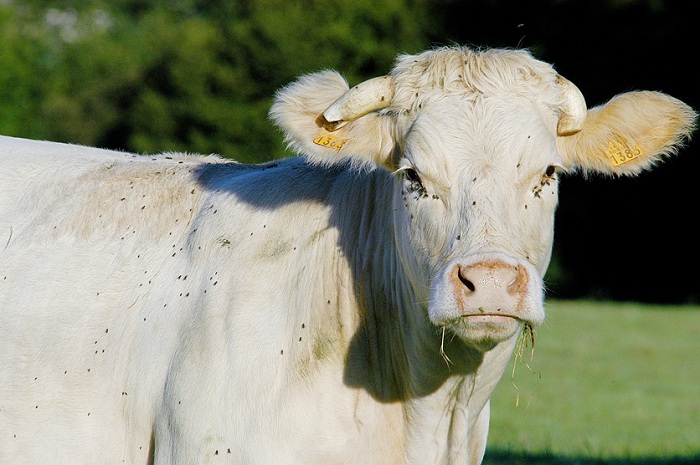
BEEF
Charolais. My main aim for lunch at the Grand Hotel Montespan Talleyrand wasn’t actually to discover those cheeses but rather to try a thick marbled rump of Charolais beef, simply grilled.
White or cream-colored Charolais cattle dot the otherwise green landscape in much of the Bourbonnais and beyond. Charolais actually derives its name from the town of Charolles in southern Burgundy, just over the regional border from the department Allier, so Burgundians naturally claim the Charolais as one of its own. Charolais developed from a strong workaday bovine into an animal bred for beef in the late 18th century. In the 19th century its breeding zone spread, including to the Bourbonnais, which remains a central breeding ground for Charolais.
Charolais du Bourbonnais, as the Red Label beef produced in the area is called, must be traditionally raised traditional with calves feeding on its mother’s milk then 8-9 months of the year at pasture, moving to the stable from the end of November to March, where it’s fed hay, fodder, cereal and grain. If interested in buying a couple of local Charolais to create your own herd, here’s where. Sheep are also raised locally for Agneau du Boubonnais. For further information on both meats see the Bourbonnais meats site.
Charolais beef is tastiest and most tender when grilled on the outside, medium rare or rarer on the inside.
By the way, grilled beef is served in France as either bleu (meaning blue), with a quick flick of less than 30 seconds on the grill, saignant (meaning bloody) with up to a minute on the grill on either side, what we would consider as rare, and à point, which might appear medium rare to medium. Bien cuit (meaning well done) would be anything beyond that, in which case the chef stops paying attention.
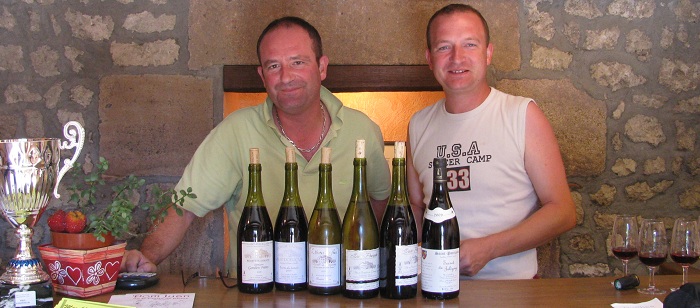
WINE
Saint Pourcain
Saint Pourcain—red, white and rosé—is among the lesser known appellations in France. For those unfamiliar with the geography of the center of France—I’m still shaky on it myself—it’s difficult to situate. It’s among a diverse grouping of wines from the Upper Loire region, which is far removed from the main body of Loire Valley vineyards. The closest major winegrowing regions are Burgundy and Beaujolais about 85 miles to the east. For those with a clearer sense of the geography of wine regions in France, the zone (and in some ways the taste) can be considered as being midway between Maconnais and Sancerre.
The production zone forms a long band along the Allier and Sioule Rivers covering a variety of soils. Part of that zone, the part that I visited, is located in the Bourbonnais.
Five main grape varietals can go into Saint Pourcain, the most area-specific being tressalier used in white wines here, along with chardonnay and sauvignon blanc. All Saint Pourcain whites must contain at least 20% of tressalier even though the predominant taste is with the chardonnay or the sauvignon. The reds and rosés are made from pinot noir and gamay, a reflection of the zones relative proximity to Burgundy for the former and Beaujolais for the latter.
Friends in Paris had served as an aperitif a nice white Saint Pourcain produced by the Laurent family a few days before this trip, but here I visited Domaine Gardien, operated by the Gardien brothers Olivier (left in photo) and Christophe (right). The domain consists of 21 hectares (52 acres) of vines in the northernmost area of the Saint Pourcain production zone. The soil of their vines is clay and flint, often with white pebbles on the topsoil.
Among the Gardien brothers’ whites I preferred those with the sauvignon left out, i.e. the 80% chardonnay/20% tressallier 2007 Réserve des Grands Jours, kept en lie and in oak barrels for 6 months, bottled two years after harvest.
There must be something to those percentages that appeal to me because it was the 80% pinot noir/20% gamay 2007 Réserve des Grands Jours that I preferred it among the reds. It’s a fairly hefty dark berry wine though not to be confused with substantial reds made further east. Earlier in the day I’d had the Secret de Jaligny, a 100% old vine pinot noir to accompany a Charolais. Though considered their top of the line I found it less notable, perhaps because I’d recently been to a Burgundy tasting and had a trip to Burgundy coming up a week later.
Saint Pourcain is largely unknown in the U.S. and the U.K. and the few bottles available there may not represent the variety of offerings available closer to the production zone. Even in Paris there are few references in wine shops. Of course, this isn’t a top French wine, in fact it’s relatively inexpensive (4-10 euros per bottle in France), but it is certainly a local attraction and, at its best, a welcome change at any dinner party.
For more on Saint Pourcain wines see the official site of the appellation.
WATER
Various bottled waters from that spring-happy Vichy basin which covers part of the Auvergne region were proposed in the restaurants where I ate during this two-day visit to the Bourbonnais. Chateldon, from just south of the area I was visiting, was my choice of the occasion because less well known (to me) and more chic than the others. Fine bubbles, a smooth and easy drink. The town of Vichy with its famous brand-name waters for drinking and spa treatment is 34 miles (55km) south of Moulins.
© 2011, Gary Lee Kraut


Thanks for introducing readers to Allier, one of many worthwhile areas to visit in Auvergne. Also enjoyed your article about Vichy. My in-laws live in Auvergne (Clermont-Ferrand) and so my husband and our two children visit the region at least once a year. A region that’s off the beaten track but well worth discovering.
Merci!
Sally D.